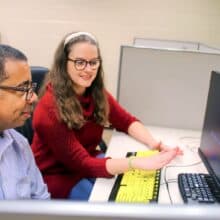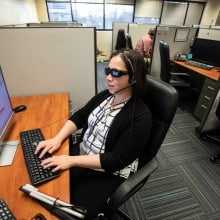Commentary: On Being Poor and Disabled
October 18, 2016
Since it’s National Disability Employment Awareness Month, Sandy is sharing one of the most popular posts from 2015 on employment and disabilities. Enjoy!
The high poverty rate and lack of opportunities for people with disabilities throughout the world are clear indications that we have not done enough to help this community. I recently read an article about the Framing Perceptions Project, a set of portraits that aim to give us a glimpse into the lives of disabled individuals in India and Uganda. Reading the many stories made me realize how fortunate I am to live in a country where plenty of opportunities exist for people with disabilities.
The people with disabilities who have job and education opportunities in these countries are far few in between. Most of the pictures tell the stories of individuals who live in poverty and depression due to their blindness or other disabilities. The story that caught my eye (no pun intended) is the one of Shyam Sundar, a man from India who was blinded by Glaucoma. He spends most of the day at home and rarely goes out. “There is nothing to be happy about,” he says.
I consider myself extremely fortunate because unlike Sundar and countless other disabled individuals throughout the world, I was born and grew up in a country where there is an abundance of opportunities for us. As a child, I was able to go to school at no cost to me. I was integrated and included with my sighted peers while receiving Braille and other independent living training. Thanks to this, I was able to study and graduate from college, and am now successfully employed.
I often travel to Mexico to visit my extended family. Each time I go, I am reminded that not all people with disabilities are as fortunate as I have been. In Mexico and many other countries, it is still common to see individuals with disabilities in the streets begging for money. Those who are more fortunate and were able to attend special schools often struggle to be accepted into colleges and universities and even to find jobs.
Of course, the equally pressing issue is that of accessibility. Uneven pavement makes it difficult for those with physical disabilities to move around safely and independently. They are all too often excluded from stores, restaurants, movie theaters and the like, simply because no ramps exist. Even in those rare instances when ramps are available, they are either blocked by parked cars or too steep, making it difficult, even impossible for a wheelchair user to climb. Sidewalks are often blocked by parked cars, food stands, and bicycles, just to mention a few. This can make it extremely difficult for people with visual and physical disabilities to navigate independently and safely.
As a person who is blind, I think that these physical barriers are not the biggest challenge for those with disabilities in Mexico and other countries. The negative attitude that still exists about disabilities all over the world is the major stumbling block for countless individuals. Many cultures still believe that people with any type of disability are sick or helpless and that it is something to be ashamed of, which results in the shunning of this population by their family and friends.
Thanks to advocacy efforts, more awareness exists about disabilities in developing countries. However, there is still a long way to go before we can truly say that all people with disabilities have equal rights. Families, communities and political and religious leaders must begin believing in the potential of these individuals and giving them more education and job opportunities.
The United States is certainly not a paradise for people with disabilities, and a good proof of this is the extremely high unemployment rate that has persisted in this community for many decades. Still, when I read about and see firsthand the exclusion and poverty of people with disabilities, I sure do feel grateful to live in a country where I can be independent and not feel ashamed of my blindness.

Sandy Murillo works at The Chicago Lighthouse, an organization serving the blind and visually impaired. She is the author of Sandy’s View, a bi-weekly Lighthouse blog about blindness and low vision. The blog covers topics of interest to those living with blindness and vision impairments. Being a blind journalist and blogger herself, Sandy shares her unique perspective about ways to live and cope with vision loss.





